1)What brain region is responsible for learning, memory, and personality?
A)Brainstem
B)diencephalon
C)cerebrum
D)cerebellum
C
2)The midbrain, pons, and medulla oblongata are all part of the __________.
A)diencephalon
B)cerebellum
C)cerebrum
D)brainstem
D
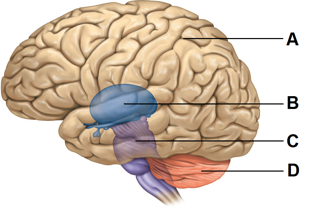
3)The cerebellum is labeled __________.
A)
B)
C)
D)
D
4)The brainstem connects the brain and the:
A)cerebellum.
B)ventricles.
C)eyes.
D)spinal cord
D
5)The cerebellum functions in:
A)the planning and coordination of movement.
B)homeostatic functions such as breathing and heart rate
C)biological rhythms.
D)learning, memory, and personality.
A
6)Bundles of white matter in the cerebrum are known as:
A)tracts.
B)ganglia.
C)nuclei.
D)nerves.
A
7)Which description best matches the location of white matter?
A)In both the brain and spinal cord, white matter is deep.
B)In both the brain and spinal cord, white matter is superficial.
C)In the spinal cord, white matter is superficial while cerebral white matter is deep.
D)In the spinal cord, white matter is deep while cerebral white matter is superficial
C
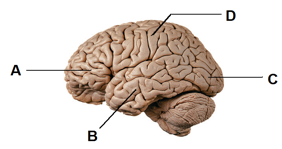
8)The occipital lobe is labeled __________.
A)
B)
C)
D)
C
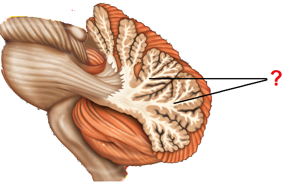
9)Name this structure of the cerebellum.
A)Vermis
B)arbor vitae
C)cerebellar cortex
D)cerebellar peduncles
B
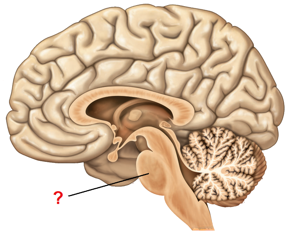
10)Name this structure of the brain.
A)thalamus
B)pons
C)medulla oblongata
D)midbrain
B
11)The neurons responsible for hearing, language, memory, and emotions can be found in the __________ lobe.
A)temporal
B)parietal
C)occipital
D)frontal
A
12)Which of the following is NOT one of the functions of the hypothalamus?
A)Control secretions from the pituitary gland
B)Regulate thirst and hunger
C)Regulate movement
D)Regulate body temperature
C
13)An elevated ridge on the surface of the cerebrum is known as a:
A)furrow.
B)fissure.
C)gyrus.
D)sulcus
C
14) Which lobe is situated posteriorly in each cerebral hemisphere?
A)frontal
B)occipital
C)temporal
D)parietal
B
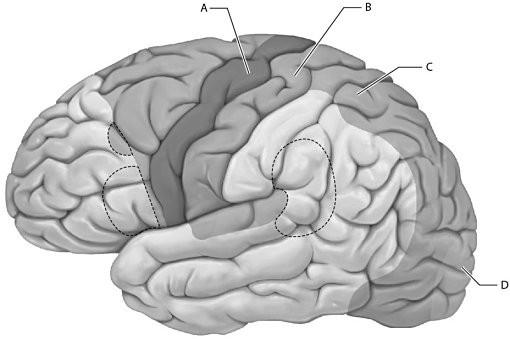
15) Select the letter that represents the location of the primary motor cortex.
A)
B)
C)
D)
A
16)The primary motor cortex of the right cerebral hemisphere:
A)controls the motor activity on the right side of the body.
B)controls the motor activity on the left side of the body.
C)receives and processes sensory input.
D)integrates senses from multiple different sources.
B
17)In 1848, Phineas Gage sustained a brain injury when an iron rod pierced through his left prefrontal cerebral cortex. What do you think was the result?
A)Gage's personality, behavior, and psychological state changed.
B)Gage was unable to understand language.
C)Gage was unable to produce language.
D)Gage was unable to move the right side of his body.
A
18) What results when the corpus callosum is cut?
A)Communication within a single brain hemisphere would be impaired.
B)Communication between the right and left cerebral hemispheres would be impaired.
C)Communication between the brain and spinal cord would be impaired.
D)Communication between a cerebral cortex in one hemisphere with other areas of the same hemisphere would be impaired.
B)
19)What best describes the Broca's area?
A)Broca's area is usually found in the right cerebral hemisphere.
B)Broca's area is housed in the temporal and parietal lobes.
C)Broca's area houses personality, decorum, and behavior.
D)Broca's area is a premotor area for speech sounds.
D
20)What functional brain system participates in memory, learning, emotion, and behavior?
A)medial lemniscal system
B)anterolateral system
C)limbic system
D)peripheral nervous system
C
21)The hypothalamus functions in:
A)secreting a hormone called melatonin.
B)coordinating movement.
C)sending information to the cerebral cortex.
D)regulating the autonomic nervous system.
D
22)What portion of the brainstem blends with the spinal cord after passing through the foramen magnum?
A)hypothalamus
B)pons
C)medulla oblongata
D)midbrain
C
23)The hippocampus and amygdala are parts of the:
A)caudate nucleus.
B)reticular formation.
C)limbic system.
D)globus pallidus.
C
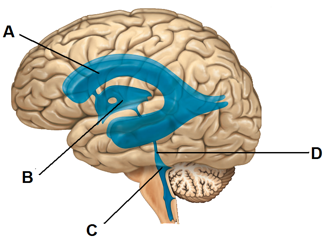
24)The third ventricle has been labeled __________.
A)
B)
C)
D)
B
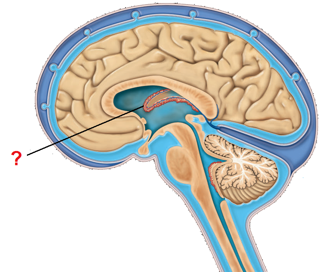
25)What is the function of the labeled structure?
A)allows CSF to be reabsorbed into blood
B)acts as the blood-brain barrier
C)secretes CSF
D)filters CSF
C
26)Which of the following is NOT a function of cerebrospinal fluid (CSF)?
A)remove wastes from brain tissue
B)protect the brain
C)maintain high intracranial pressure
D)increase the buoyancy of the brain
C
27)The delicate, innermost cranial meninx is the __________.
A)arachnoid mater
B)pia mater
C)dura mater
D)falx cerebri
B
28)Which of the following is NOT a component of the blood-brain barrier?
A)Astrocytes
B)High numbers of tight junctions in brain capillaries
C)The endothelial cells of brain capillaries
D)The meninges
D
29)Cerebrospinal fluid (CSF) in the third ventricle will drain into the:
A)dural sinus.
B)fourth ventricle.
C)lateral ventricles.
D)choroid plexus.
B
30)Cerebrospinal fluid (CSF) circulates through the:
A)dura mater.
B)blood-brain barrier.
C)subarachnoid space.
D)pia mater.
C
31)Which of the following cells secretes CSF into the ventricles of the brain?
A)basal nuclei
B)Substantia nigra
C)Ependymal cells
D)microglia
C
32)Which of the following should NOT cross the blood-brain barrier with ease?
A)carbon dioxide
B)lipid-based molecules
C)glucose
D)large, polar molecules
D
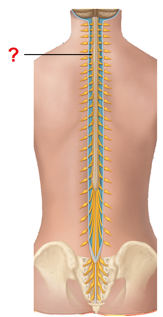
33)This area of the spinal cord is known as the __________.
A)cervical enlargement
B)conus medullaris
C)lumbar enlargement
D)cauda equina
A
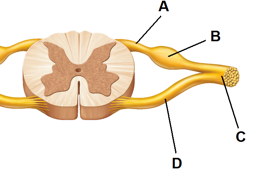
34)The cell bodies of sensory neurons are located inside __________.
A)
B)
C)
D)
B
35)The inferior end of the spinal cord is the __________.
A)filum terminale
B)cauda equina
C)posterior median sulcus
D)conus medullaris
D
36)While observing a cross-section of the spinal cord under the microscope, you notice a butterfly-shaped area on the inside. You would identify this as the __________.
A)central canal
B)white matter
C)spinal meninges
D)gray matter
D
37)Epidural anesthesia is injected into the __________.
A)space between the meningeal dura mater and the periosteal dura mater
B)space between the arachnoid mater and the pia mater
C)space between the meningeal dura mater and the bone of the vertebral foramen
D)space between the dura mater and the arachnoid mater
C
38)An injury to the spinal cord is not possible below the:
A)ninth thoracic vertebra.
B)second thoracic vertebra.
C)fourth cervical vertebra.
D)second lumbar vertebra.
D
39)What is situated inferior to the conus medullaris of the spinal cord?
A)cauda equina
B)cervical enlargement
C)lumbar enlargement
D)posterior median sulcus
A
40)In the spinal cord, nerve tracts or funiculi make up the:
A)gray horns.
B)white columns.
C)gray commissure.
D)central canal.
B
41)The hole in the spinal cord through which CSF flows is the:
A)anterior median fissure
B)intervertebral foramen.
C)central canal.
D)vertebral foramen.
C
42)What part of the spinal cord carries motor information from the brain?
A)anterolateral system
B)corticospinal tract
C)posterior column
D)spinocerebellar tract
B
43)Which of the following is NOT one of the special senses?
A)olfactory
B)audition
C)gustation
D)tactile
D
44)The _____________ is responsible for the interpretation of sensory stimuli and the formation of perceptions. Sensory stimuli are interpreted and perceptions are formed in the __________.
A)sensory neurons of the PNS
B)spinal cord
C)thalamus
D) cerebral cortex
D
45)Compared to homeostatic regulation by the endocrine system, homeostatic regulation by the nervous system __________.
A)depends on hormones
B)has a longer-lasting effect
C)uses action potentials
D)is slower
C
46)Our "biological clock," which controls sleep and wake cycles, is located in the __________.
A)substantia nigra
B)cerebral cortex
C)hippocampus
D)hypothalamus
D
47)Compared to homeostatic regulation by the nervous system, homeostatic regulation by the endocrine system __________.
A)uses electrical signals
B)opposes nervous system effects
C)is immediate
D)is slower
D
48)What provides a link between the nervous system and the endocrine system?
A)thalamus
B)hypothalamus
C)cerebellum
D)pons
B
49) What part of the brain is the "boss" of the autonomic nervous system (ANS)?
A)thalamus
B)hypothalamus
C)cerebellum
D)pons
B
50)The deepest stage of sleep is experienced during:
A)stage I.
B)stage III.
C)stage VI.
D)stage IV.
C
51)Cognition is best described as:
A)the ability to comprehend and produce words.
B)recognizing, processing, planning, and responding to stimuli.
C)a reversible and normal suspension of consciousness.
D)encoding and storing learned information in our neural circuitry.
B
52)What part of the cerebral cortex is responsible for personality, the creation of an awareness of self, and the ability to recognize appropriate behavior?
A)parietal association cortex
B)prefrontal cortex
C)Wernicke's area
D)temporal association cortex
B